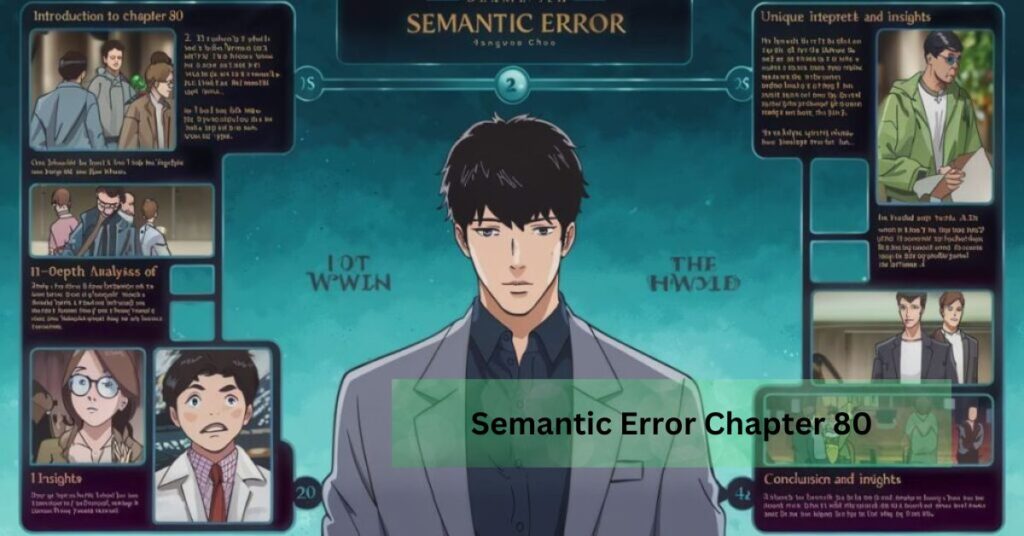Among the chapters, Chapter 80 stands out as one of the series’s most mysterious and thought-provoking segments. It doesn’t follow the typical narrative style seen in other chapters, making it an enigmatic puzzle for fans to dissect.
The Ambiguity of Chapter 80
What Makes Chapter 80 Unique?
Chapter 80 deviates from the established narrative style of the “Semantic Error” manhwa. Its non-linear structure and unclear plot left readers baffled, raising more questions than answers.
This chapter seems to lack an official confirmation from the author regarding its purpose, which only adds to the speculation. Fans have been left wondering whether it was a legitimate continuation of the story or simply a fan theory.
Some fans view Chapter 80 as an authentic part of the series, while others believe it is a fan-driven narrative or even an inside joke within the community. Regardless of its origins, Chapter 80 has become a vital talking point for the “Semantic Error” fandom. It represents the complexities of interpretation, allowing fans to explore its deeper meanings and speculate on its purpose.
The Debate: Fact or Fiction?
The ongoing debate centers around whether Chapter 80 is an official part of the manhwa. The creator’s lack of direct clarification has led some readers to believe that it might be a fan creation or an exaggerated myth within the fandom. However, despite the lack of a clear answer, the existence of this chapter—whether real or fictional—has only amplified its influence, making it a cornerstone of discussion within the fan community.
Possible Interpretations of Chapter 80
Allegorical Representation of Errors in Storytelling
The title “Semantic Error” itself draws a comparison between errors in programming and potential narrative mistakes. In programming, a semantic error is an issue in logic that allows a program to run but produces incorrect results. This parallel leads some fans to interpret Chapter 80 as a metaphorical “error” within the story, signifying that while the narrative continues, it is not unfolding as expected.
This interpretation invites readers to review previous chapters, searching for inconsistencies or moments where the plot may have diverged from its intended path. In this sense, Chapter 80 acts as a thematic puzzle, encouraging a deeper, analytical reading of the entire manhwa.
Breaking the Fourth Wal
Another compelling theory suggests that Chapter 80 intentionally breaks the fourth wall, a method the author uses to acknowledge the difficulties in writing and storytelling. By presenting a confusing or ambiguous chapter, the creator could invite readers to understand the challenges storytellers face, particularly in a series as intricate as “Semantic Error.”
Through this lens, Chapter 80 is seen not as a mistake but as a deliberate choice to connect with readers personally, acknowledging their close attention to plot details and inviting them to participate in constructing the story’s meaning.
A Chapter Lost in Translation
Some fans speculate that the confusion surrounding Chapter 80 stems from issues in translation. “Semantic Error” was originally written in Korean, and certain cultural or linguistic nuances may not have been fully captured in other languages. This theory posits that the chapter may have contained elements lost or misinterpreted during translation, contributing to the widespread perplexity.
While this theory remains speculative, it highlights the importance of considering the cultural and linguistic contexts in which the manhwa was created. Misinterpretations in translation are not uncommon, and they can sometimes lead to a significant shift in how a chapter is understood.
Thematic Analysis of Chapter 80
Miscommunication and Misunderstanding
One of the most central themes in “Semantic Error” is the tension caused by miscommunication between characters. The primary conflict between Sang-woo and Jaekyung revolves around misunderstandings, and Chapter 80, with its elusive narrative, mirrors this theme of confusion and lack of clarity. Readers are left to piece together the missing fragments, much like how the characters struggle to resolve their differences.
This narrative device creates a parallel between the readers’ experience and the characters’ emotional journeys, reinforcing the idea that communication, whether between characters or between the author and audience, is inherently complex and fraught with potential errors.
Embracing Imperfections in Storytelling
Chapter 80 challenges the conventional expectations of storytelling by embracing imperfections and ambiguity. In a world where readers often expect neatly tied-up plotlines and clear resolutions, Chapter 80 offers the opposite. It is an unfinished, unresolved piece that forces readers to grapple with its open-endedness.
This approach adds a layer of realism to the narrative, as real-life communication and relationships are seldom perfect. Chapter 80 invites readers to appreciate the beauty of imperfection and uncertainty, emphasizing that not every story aspect needs to be fully explained or resolved.
Symbolism and Meta-Narratives
In addition to its thematic depth, Chapter 80 also employs a significant amount of symbolism. The absence of a clear plot could be seen as a metaphor for the incompleteness of certain human experiences. Just as a “semantic error” in programming does not prevent a program from running, the absence of clarity in Chapter 80 does not derail the overall narrative.
This symbolic use of error and absence challenges readers to engage more actively with the story. Instead of passively consuming the narrative, they must fill in the gaps, using their interpretations to make sense of the chapter.
Fan Engagement and Community Interpretations
The Role of Fan Theories
Chapter 80’s ambiguity has made it a fertile ground for fan theories. Without an official explanation from the creator, fans have taken it upon themselves to speculate on the chapter’s meaning and significance. These theories range from metaphorical interpretations to more concrete ideas about hidden plotlines or overlooked details in previous chapters.
The diverse range of fan interpretations reflects the depth of engagement that Chapter 80 has fostered within the “Semantic Error” community. Fans feel empowered to contribute to the story, adding their voices to the broader narrative discussion.
Chapter 80 as a Catalyst for Discussion
The lack of definitive answers surrounding Chapter 80 has led to many fan discussions. Online forums, social media platforms, and fan communities have become hubs of activity, where readers share their interpretations, debate different theories, and try to make sense of the chapter’s mysteries.
This active participation goes beyond simply consuming the manhwa; it becomes a form of collective storytelling where readers feel a sense of ownership over the narrative. In this way, Chapter 80 has become a catalyst for fan-driven content, including fan art, alternative storylines, and speculative essays.
Insights into Chapter 80’s Narrative Structure
Conflict and Resolution in Chapter 80
Chapter 80 stands as a pivotal moment of conflict within the series. Characters are faced with intense confrontations that bring long-standing tensions to the forefront. The unresolved nature of these conflicts keeps readers on edge, wondering how the story will move forward.
This chapter forces the characters and the readers to confront the complexities of relationships, where solutions are not always clear-cut. The absence of resolution mirrors the ongoing nature of personal growth and emotional healing, reminding readers that some conflicts are not easily solved.
Key Scenes and Symbolism
Key moments in Chapter 80 are loaded with symbolic meaning. Whether it’s the interactions between characters or the way certain objects are framed within the scenes, an underlying symbolism speaks to broader themes of misunderstanding, imperfection, and the limitations of human communication.
Readers are encouraged to look beyond the narrative’s surface and delve into these symbolic elements, seeking hidden meanings that add depth to the story.
Why Chapter 80 Resonates Beyond the Manhwa
Chapter 80 blurs the lines between fiction and reality, allowing readers to project their interpretations onto the story. This fluidity between the narrative and the reader’s personal experiences makes Chapter 80 an intensely subjective reading experience, where each reader takes away something unique.
Ultimately, Chapter 80 embodies many of the broader themes present throughout the “Semantic Error” series, particularly those related to the nature of communication, the challenges of understanding others, and the imperfections inherent in human relationships.
The Future of “Semantic Error” and Speculations Post Chapter 80
Chapter 80 is a turning point in the series, and fans are eager to see how the story will progress. The chapter leaves many questions unanswered, setting the stage for future developments that could reshape the narrative.
With so many unresolved plot points, Chapter 80 leaves readers in suspense. The lack of clear resolution allows for a wide range of potential outcomes, and fans are left to speculate on how the characters will move forward from this pivotal moment.
FAQs
1. What Is The Significance Of Chapter 80 In The Series?
Chapter 80 marks a pivotal moment in the series. It introduces ambiguity and leaves fans with unresolved questions that fuel speculation about the story’s direction.
2. Is Chapter 80 Part Of The Official Storyline Or A Fan Theory?
While some believe it is a legitimate chapter, the creator has not officially confirmed this, leaving it open to interpretation.
3. How Does Chapter 80 Relate To The Concept Of “Semantic Errors”?
The chapter metaphorically mirrors the concept of a semantic error, where the story appears to progress but contains hidden flaws that lead to confusion.
4. Why Has Chapter 80 Sparked So Much Fan Discussion?
The story’s ambiguous nature and lack of clear answers have led fans to actively theorize and engage with it, creating a vibrant community of discussion.
5. What Can Readers Expect After Chapter 80?
Chapter 80 sets the stage for significant future developments in the series, leaving many plot points for subsequent chapters to explore.
Conclusion
Chapter 80 of “Semantic Error” is a complex, enigmatic installment that invites deep analysis and discussion. Its ambiguity challenges traditional storytelling conventions, offering readers the chance to engage with the narrative in a more active and personal way. Whether viewed as a metaphor for miscommunication, a break in the fourth wall, or a reflection of real-world errors, Chapter 80 holds a unique place in the manhwa’s storyline and in the hearts of its fans.

